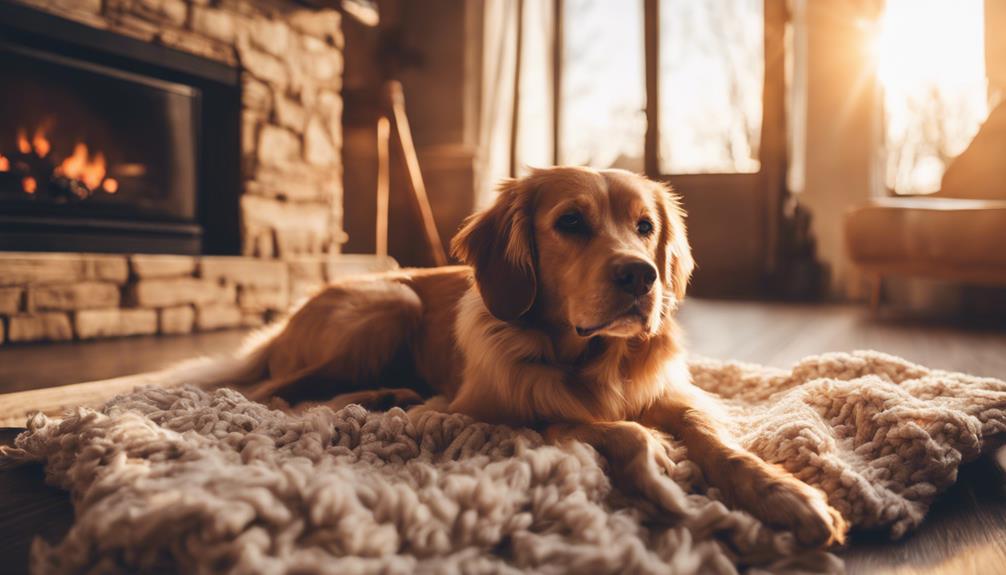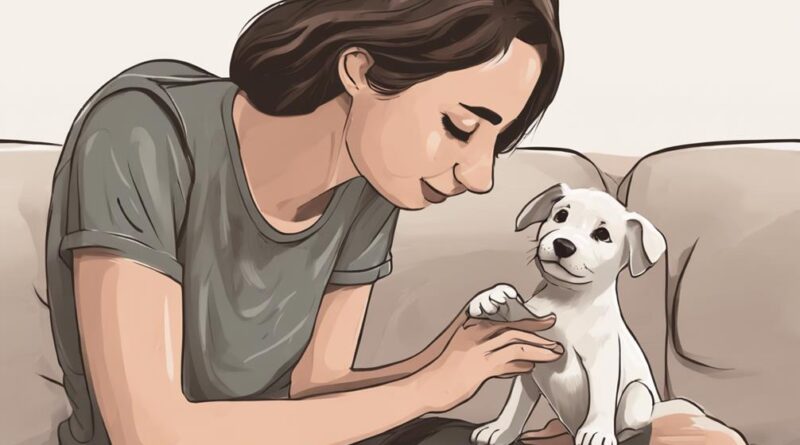Understanding Your Pup: A Guide for New Owners
Did you know that over 50% of new dog owners feel overwhelmed by their furry companions' behavior in the first few months? Understanding your pup is the key to building a strong bond and creating a harmonious relationship.
Exploring the intricacies of canine social behavior, communication signals, and body language can pave the way for a deeper connection with your four-legged friend. Discovering how to navigate canine anxiety, establish trust, and implement positive reinforcement techniques will empower you to become a confident and understanding dog owner.
Canine Social Behavior
Understanding canine social behavior is crucial for new dog owners as it helps create a strong bond between you and your pup. Play behavior is a key aspect of this social interaction. By engaging in play, dogs learn essential social skills, establish boundaries, and strengthen their relationship with you. It's important to recognize the different types of play behavior, such as play fighting and chase games, as they help dogs develop communication and problem-solving abilities.
In addition to play behavior, understanding dominance hierarchy is vital. Dogs are pack animals with a natural inclination towards establishing a social order. As a new owner, you play a significant role in establishing yourself as the leader of the pack. By setting clear rules and boundaries, you help your pup understand their place in the family unit. This clarity reduces confusion and promotes a harmonious relationship based on trust and respect. Being aware of dominance dynamics ensures a healthy and balanced coexistence between you and your furry companion.
Pack Mentality
Establishing a strong pack mentality is essential for fostering a harmonious relationship with your dog. Dogs are pack animals by nature, and understanding the dominance hierarchy within the pack dynamics is crucial for effective communication and training. In a dog pack, there's a clear order of dominance, with each member knowing its place in the hierarchy. As a pet owner, you must establish yourself as the pack leader to earn your dog's respect and trust.
To maintain a healthy pack dynamic, it's important to set clear boundaries and rules for your dog to follow. Consistency in enforcing these guidelines will help reinforce your position as the leader. Remember, being a pack leader doesn't mean being harsh or aggressive; it means being firm, fair, and providing guidance.
Canine Communication Signals
To effectively communicate with your pup, pay close attention to the subtle signals they use to convey their thoughts and feelings. Understanding these cues is crucial for building a strong bond with your furry companion.
Here are four key communication signals used by canines:
- Vocal cues: Dogs use different sounds such as barking, growling, whining, and whimpering to express themselves. Pay attention to the tone and intensity of their vocalizations to interpret their emotions.
- Scent signals: Dogs have a keen sense of smell and use scent signals to communicate with other animals. They mark their territory with urine and rely on scent to identify other dogs and objects in their environment.
- Body language: Watch for body posture, tail wagging, ear position, and facial expressions to understand your pup's mood and intentions.
- Social cues: Dogs are social animals and use signals like play bows, licking, and eye contact to interact with humans and other dogs. Recognizing and responding to these cues will help strengthen your bond with your pup.
Understanding Dog Body Language
Pay attention to your pup's body language as it provides valuable insights into their mood and intentions. When your pup wags its tail, it usually signifies happiness and excitement. However, not all tail wags are the same; a fast wagging tail could mean they're overstimulated, while a slow wag might indicate uncertainty. Understanding your pup's tail language can help you respond appropriately to their needs.
Ear positioning is another essential aspect of dog body language. If your pup's ears are perked up and facing forward, they're likely alert and attentive. On the other hand, ears flattened against the head might indicate fear or submission. Observing your pup's ear movements can give you clues about how they're feeling in different situations.
Canine Anxiety and Stress
Understanding signs of anxiety and stress in your pup is crucial for ensuring their well-being and addressing any underlying issues effectively. Dogs, like humans, can experience a range of emotions that may lead to anxiety and stress. It's important to be able to recognize these signs to provide the necessary support and comfort to your furry friend.
- Separation Anxiety: Dogs can exhibit separation anxiety when left alone, leading to behaviors like excessive barking, destructive chewing, or house soiling.
- Fear Aggression: Some dogs may display aggression when they're afraid or stressed. It's essential to understand the triggers and work on desensitization techniques.
- Noise Sensitivity: Dogs with noise sensitivity may become anxious or stressed when exposed to loud noises, such as fireworks or thunderstorms.
- Thunderstorm Phobia: This is a common fear in dogs and can lead to shaking, hiding, or seeking comfort during storms.
Building Trust With Your Dog
Building a strong bond with your dog starts with consistent and positive interactions. Creating trust is essential in your relationship with your pup. Engage in bonding activities such as interactive play sessions, grooming routines, and training exercises. These activities not only strengthen your connection but also provide mental stimulation and physical exercise for your furry friend. Building rapport through positive reinforcement and rewards will help your dog feel secure and confident in your presence.
Spending quality time together is crucial for fostering trust. Take your dog for daily walks, explore new environments, and introduce them to new experiences. These shared moments help your dog understand that you're a source of comfort and safety. Consistency in your interactions and reactions is key to building trust. Dogs thrive on routine and predictability, so establishing a consistent schedule for feeding, exercise, and playtime will create a sense of security for your pup.
The Importance of Routine

Establishing a consistent daily routine is crucial for your dog's well-being and overall happiness. Dogs thrive on predictability and structure, which can significantly impact their behavior and attitude. Here are four key reasons why maintaining a routine is essential for your furry companion:
- Training Consistency: Following a set routine helps reinforce training commands and expectations. Consistent schedules make it easier for your dog to understand what's expected of them, leading to better behavior predictability.
- Behavior Predictability: Dogs feel more secure and confident when they know what to expect. A routine provides a sense of stability that can help reduce anxiety and prevent unwanted behaviors.
- Daily Schedules: Having a set daily schedule for feeding, walks, playtime, and rest helps your dog feel secure and provides mental stimulation. A structured day can also reduce stress and promote a sense of security.
- Stress Reduction: Predictable routines can lower your dog's stress levels by creating a safe and familiar environment. Reduced stress leads to a happier and healthier pup overall.
Positive Reinforcement Training
Consistently using positive reinforcement techniques is key to fostering a strong bond with your pup and encouraging desired behaviors. Treat training is a popular method where you reward your pup with a treat immediately after they display the desired behavior. This method associates good behavior with a positive outcome, reinforcing the behavior you want to see more of. It's important to use high-value treats to keep your pup motivated and engaged during training sessions.
Clicker training is another effective positive reinforcement technique. By using a clicker—a small device that makes a clicking sound—you can mark the exact moment your pup performs the desired behavior, followed by a treat. The click sound acts as a signal to your pup that they've done something right and that a treat is on the way. This method helps in precise communication and accelerates the learning process for your pup.
Frequently Asked Questions
How Can I Help My Puppy Adjust to a New Environment?
When helping your puppy adjust to a new environment, start by using crate training to provide a safe space.
Introduce them gradually to different aspects of their surroundings. Implement socialization techniques like positive reinforcement when they interact with new people, animals, and environments.
What Are Some Common Mistakes New Dog Owners Make When Training Their Pup?
When training your pup, common mistakes new owners make include potty training pitfalls like not being consistent with scheduled bathroom breaks and waiting too long to take them out.
Another error is lacking consistency in commands, confusing your dog. Remember to use the same cues for each behavior and reward good behavior immediately.
How Can I Prevent Separation Anxiety in My Dog?
To prevent separation anxiety in your dog, start with crate training. Introduce the crate as a safe space and gradually increase alone time.
Use socialization techniques to help your pup feel comfortable around new people and environments. Encourage positive interactions with other dogs and humans.
Consistent routines and gradual exposure to being alone can also help in preventing separation anxiety. Remember, patience and positive reinforcement are key in training your furry companion.
Should I Be Concerned if My Dog Doesn't Like Certain People or Other Dogs?
If your dog shows aversion towards certain people or other dogs, it's essential to address this behavior. Behavioral training and socialization are key to help your pup feel comfortable and confident around others.
Observing canine body language can give insight into their feelings. Fear aggression could be a factor, so it's crucial to seek guidance from a professional trainer to manage these situations effectively and ensure the safety of all involved.
What Are Some Tips for Introducing My Dog to New Experiences and Environments?
When introducing your dog to new experiences and environments, start by using socialization techniques and desensitization exercises. Offer positive reinforcement and gradually expose your pup to different situations.
Stay patient and supportive throughout the process. Remember to create a safe and calm environment for your dog to feel more comfortable and confident.
Conclusion
Now that you have a better understanding of your pup's social behavior, communication signals, body language, anxiety, and stress, you can start building a stronger bond with your furry friend.
Remember to establish trust through routine and positive reinforcement training. By being attentive to your dog's needs and cues, you can create a happy and healthy relationship that will benefit both of you for years to come.
Enjoy the journey of being a dog owner!
